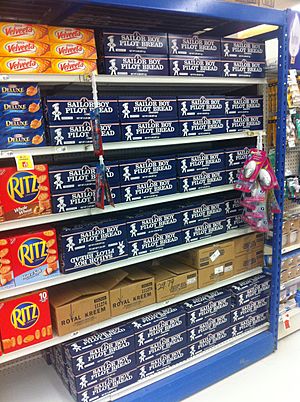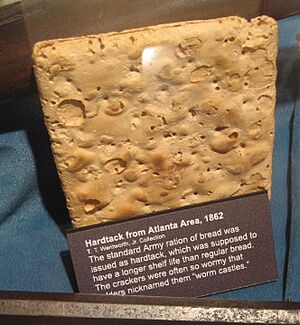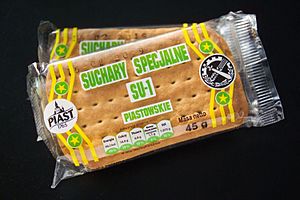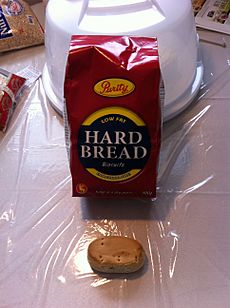Hardtack facts for kids

A preserved hardtack from U.S. Civil War at a museum display
|
|
| Alternative names | ANZAC wafers, brewis, cabin bread, dog biscuit, hard tack, molar breakers, pilot bread, sea biscuit, sea bread, sheet iron, ship's biscuit, shipbiscuit, tooth dullers, worm castles |
|---|---|
| Type | Cracker or biscuit |
| Main ingredients | Flour, water |
Imagine a super tough cracker that lasts a really long time! That's hardtack. It's a simple biscuit or cracker made from just flour, water, and sometimes salt. Because it's cheap and doesn't spoil easily, hardtack was a perfect food for long trips, like sea voyages, land journeys, and military missions. For hundreds of years, from the 1600s to the 1800s, hardtack was a common ration (a set amount of food) for soldiers and sailors, often eaten with salt pork.
Contents
What's in a Name?
Hardtack has many nicknames! The name "hardtack" comes from "tack," which was British sailor slang for food. People also called it brewis, cabin bread, pilot bread, sea biscuit, sea bread, or ship's biscuit because sailors ate it so much.
Sometimes, people gave it funny or not-so-nice names because it was so hard to eat. These included dog biscuits, molar breakers, sheet iron, tooth dullers, armor plates (in Germany), and worm castles. Soldiers from Australia and New Zealand jokingly called them ANZAC wafers.
A Brief History of Hardtack
Humans have been making tough, long-lasting bread for thousands of years.
- Ancient Egyptian sailors carried a flat, crunchy bread made from millet.
- The Romans had a biscuit called bucellatum.
- When King Richard I went on the Third Crusade (1189–1192), his soldiers ate "biskit of muslin," a mix of barley, bean flour, and rye.
Early doctors even thought eating a biscuit every day was good for your health!
Why Was Hardtack So Hard?
Bakers made hardtack as hard as possible on purpose. Why? Because the harder it was, the longer it would last without going bad, as long as it stayed dry. For really long sea trips, hardtack was even baked four times (instead of the usual two) and prepared six months before the ship sailed! This super-hard baking meant it could handle rough journeys and extreme temperatures.
Eating Hardtack in the Past
Eating hardtack by itself was almost impossible because it was so tough. People often had to dunk it in liquids like brine (salty water), coffee, or other drinks to soften it. Sometimes, they even cooked it into meals.
- In 1588, a sailor on a Royal Navy ship got one pound of hardtack and a gallon of small beer every day.
- In the late 1700s, hardtack was crumbled and used to thicken seafood chowders in New England.
Hardtack in America
In 1801, a baker named Josiah Bent started making "water crackers" in Milton, Massachusetts. These were perfect for long sea voyages from Boston.
- During the California Gold Rush in 1849, gold prospectors carried hardtack on their long journeys because it lasted so long.
- Josiah Bent's company later supplied hardtack to soldiers during the American Civil War (1861–1865).
Hardtack During the Civil War
During the American Civil War, soldiers received hardtack that was about three inches by three inches (7.5 cm by 7.5 cm). Soldiers often complained about how bad their rations were. They even sang a satirical song called "Hard Tack Come Again No More" to the tune of "Hard Times Come Again No More". The song joked about the hardtack being "old and very wormy" and causing "stomachs sore." Some of this hardtack was so old it had been stored since the 1846–1848 Mexican–American War!
Because food storage wasn't always perfect, hardtack often had insects, especially weevil larvae. Soldiers would break up the hardtack and drop it into their morning coffee. This softened the hardtack, and the insects would float to the top, allowing the soldiers to skim them off before eating.
Soldiers also found other ways to eat it:
- They would break it up with their rifle butts and add water to make a mush.
- If they had a frying pan, they'd cook the mush into a lumpy pancake.
- They sometimes mixed hardtack with brown sugar, hot water, and even whiskey to make a dessert they called "pudding."
During Queen Victoria's time, the Royal Navy used machines to make hardtack at the Royal Clarence Victualing Yard in Gosport, Hampshire. These machine-made biscuits were hexagonal (six-sided), which saved material and time, and made them easier to pack than round ones. Hardtack was a key part of the Royal Navy's diet until canned foods became common in the mid-1800s.
Hardtack and War Slogans
During the Spanish–American War in 1898, some military hardtack was stamped with the phrase "Remember the Maine", a slogan related to the sinking of the USS Maine battleship.
Hardtack Today
Today, hardtack is still a good source of food energy in a small, tough package. A typical store-bought cracker can have about 100 kilocalories (a measure of energy), 2 grams of protein, and almost no fiber.
Hardtack Around the World
- Asia:
- In Japan and South Korea, hardtack is called Kanpan (乾パン) or geonbbang (건빵), meaning 'dry bread'. It's still a popular snack and is even given out in Japan as emergency rations for disasters like earthquakes.
- A tougher version called Katapan (堅パン) is a specialty in Kitakyushu City, Japan.
- In Korea, geonppang is often mixed with star candy for a sweet snack.
- Europe:
- In Genoa, Italy, hardtack is still used in a traditional fish and vegetable salad called cappon magro.
- In Russia, hardtack is called galeta (галета) and is a staple in military rations, especially for the Navy. It's usually a bit softer than traditional hardtack because it contains some fat.
- In Germany, military hardtack is jokingly called Panzerplatten (armor plates) because it's so tough. It's also popular with civilians.
- In Poland, hardtacks (called Suchary Specjalne SU-1 or SU-2) are still in military rations and are jokingly called Pancerwafle (Armor wafers).
- Melanesia:
- Hardtack is very popular in Papua New Guinea, with the Lae Biscuit Company making many different kinds.
Hardtack in North America
Canada
Hardtack is still a common food in parts of Canada, especially in Newfoundland and Labrador. Purity Factories, a Canadian company, makes a very dense, high-calorie hardtack.
- They make a cracker similar to an unsalted saltine and hardtack, called Crown Pilot Crackers.
- Their "Hard Bread" is traditional hardtack and is a main ingredient in fish and brewis, a traditional Newfoundland meal.
- They also make "Sweet Bread," which is a bit softer and sweeter, eaten as a snack.
United States

In the United States, most commercially available hardtack is made by Interbake Foods under the "Sailor Boy" label.
- A huge amount (98%) of their hardtack goes to Alaska. Alaskans still eat hardtack as a regular part of their diet because it can handle tough transportation conditions.
- Alaskan law even requires small planes to carry "survival gear," including food, so you'll often see Sailor Boy Pilot Bread boxes at Alaskan airstrips and in cabins.
- Unlike traditional hardtack, Sailor Boy Pilot Bread has leavening (something that makes bread rise) and vegetable shortening.
Hardtack is also a common food in Hawaii, where Diamond Bakery's "Saloon Pilot" cracker is popular.
Many people in the continental U.S. buy or bake hardtack for emergency food supplies or for camping trips because it lasts so long. It's also popular with Civil War re-enactors who want to experience what soldiers ate back then.
See also
 In Spanish: Galleta marinera para niños
In Spanish: Galleta marinera para niños





